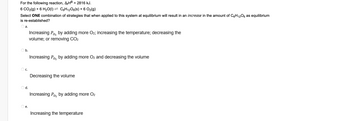
Chemistry
10th Edition
ISBN: 9781305957404
Author: Steven S. Zumdahl, Susan A. Zumdahl, Donald J. DeCoste
Publisher: Cengage Learning
expand_more
expand_more
format_list_bulleted
Question

Transcribed Image Text:For the following reaction, AH = 2816 kJ.
6 CO₂(g) + 6 H₂O(I) ⇒ C6H12O6(s) + 6 O₂(g)
Select ONE combination of strategies that when applied to this system at equilibrium will result in an increase in the amount of C6H₁2O6 as equilibrium
is re-established?
a.
Increasing Po₂ by adding more O2; increasing the temperature; decreasing the
volume; or removing CO₂
b.
Increasing Po₂ by adding more O₂ and decreasing the volume
C.
Decreasing the volume
d.
Increasing Po₂ by adding more O₂
e.
Increasing the temperature
Expert Solution
This question has been solved!
Explore an expertly crafted, step-by-step solution for a thorough understanding of key concepts.
This is a popular solution
Trending nowThis is a popular solution!
Step by stepSolved in 2 steps with 2 images

Knowledge Booster
Learn more about
Need a deep-dive on the concept behind this application? Look no further. Learn more about this topic, chemistry and related others by exploring similar questions and additional content below.Similar questions
- For the reaction 2 SO2 (g) + O2 (g) <=> 2 SO3 (g), at 250oC the equilibrium mixture contains 0.60 atm SO2, 1.3 atm O2, and 2.1 atm SO3. Determine Kp for this reaction.arrow_forwardConsider the reaction SbH5 (g) SbH3 (g) + H2 (g) If 0.500 atm of SbH5 is introduced into an empty, closed container at 248oC and the system is allowed to reach equilibrium, 0.397 atm of SbH5 remains. Find Kp and Kc.arrow_forwardConsider the following system at equilibrium where Ho = 18.8 kJ, and Kc = 9.52E-2, at 350 K: CH4(g) + CCl4(g) 2 CH2Cl2(g) If the VOLUME of the equilibrium system is suddenly decreased at constant temperature: whats the value of Kc The value of Q The reaction mustarrow_forward
- I want solutions of all parts... Otherwise I will downvotearrow_forward14.98 The equilibrium constant Kc for the synthesis of methanol (i.e. CH3OH) with reaction CO(g) + 2H2(g) CH3OH8) is 4.3 at 250 °C and 1.8 at 275 °C. Is this reaction endothermic or exothermic?arrow_forwardApply Le Chatelier's principle and decide how (by altering temperature, pressure, etc.) you could increase the amount of the products in the following reactions: 1) 2CO2 (g) ----> 2CO (g) + O2 (g) AHº=566 kJ 2) 2SO2 (g) + O2 (g) ----> 2SO3 (g)arrow_forward
- Consider the following equilibrium: 2NH, (g) – N, (g) + 3H, (g) AG° = 34. kJ Now suppose a reaction vessel is filled with 5.02 atm of ammonia (NH,) and 9.40 atm of nitrogen (N,) at 159. °C. Answer the following questions about this system: rise Under these conditions, will the pressure of N, tend to rise or fall? fall Is it possible to reverse this tendency adding H2? In other words, if you said the pressure of N, will tend to rise, can that be yes changed to a tendency to fall by adding H,? Similarly, if you said the no pressure of N, will tend to fall, can that be changed to a tendency to rise by adding H2? If you said the tendency can be reversed in the second question, calculate the minimum pressure of H, needed to reverse it. atm Round your answer to 2 significant digits.arrow_forward8. Consider the equilibrium reaction: N2(g) + O2(g) = 2 NO(g) Kp 4.10 x 10³ at 2000°C a) If 1.00 atm of nitrogen gas and 1.00 atm of oxygen gas is mixed with 0.10 atm of nitrogen monoxide in a 500.0 mL container at 2000°C, in which direction will the reaction proceed to reach equilibrium? Show all work to justify your answer. b) What is the concentration of each gas when equilibrium is reached at 2000°C? Show all your work. Equilibrium Partial Pressures: PN₂ = Po₂ = 1.02 atm and PNO = 0.07 atm Use PV = nRT Answer: Equilibrium Concentrations: [N₂] = [0₂] = 5.47 x 10-3 mol/L and [NO] = 4 x 10+ Marrow_forward7arrow_forward
arrow_back_ios
arrow_forward_ios
Recommended textbooks for you
 ChemistryChemistryISBN:9781305957404Author:Steven S. Zumdahl, Susan A. Zumdahl, Donald J. DeCostePublisher:Cengage Learning
ChemistryChemistryISBN:9781305957404Author:Steven S. Zumdahl, Susan A. Zumdahl, Donald J. DeCostePublisher:Cengage Learning ChemistryChemistryISBN:9781259911156Author:Raymond Chang Dr., Jason Overby ProfessorPublisher:McGraw-Hill Education
ChemistryChemistryISBN:9781259911156Author:Raymond Chang Dr., Jason Overby ProfessorPublisher:McGraw-Hill Education Principles of Instrumental AnalysisChemistryISBN:9781305577213Author:Douglas A. Skoog, F. James Holler, Stanley R. CrouchPublisher:Cengage Learning
Principles of Instrumental AnalysisChemistryISBN:9781305577213Author:Douglas A. Skoog, F. James Holler, Stanley R. CrouchPublisher:Cengage Learning Organic ChemistryChemistryISBN:9780078021558Author:Janice Gorzynski Smith Dr.Publisher:McGraw-Hill Education
Organic ChemistryChemistryISBN:9780078021558Author:Janice Gorzynski Smith Dr.Publisher:McGraw-Hill Education Chemistry: Principles and ReactionsChemistryISBN:9781305079373Author:William L. Masterton, Cecile N. HurleyPublisher:Cengage Learning
Chemistry: Principles and ReactionsChemistryISBN:9781305079373Author:William L. Masterton, Cecile N. HurleyPublisher:Cengage Learning Elementary Principles of Chemical Processes, Bind...ChemistryISBN:9781118431221Author:Richard M. Felder, Ronald W. Rousseau, Lisa G. BullardPublisher:WILEY
Elementary Principles of Chemical Processes, Bind...ChemistryISBN:9781118431221Author:Richard M. Felder, Ronald W. Rousseau, Lisa G. BullardPublisher:WILEY

Chemistry
Chemistry
ISBN:9781305957404
Author:Steven S. Zumdahl, Susan A. Zumdahl, Donald J. DeCoste
Publisher:Cengage Learning

Chemistry
Chemistry
ISBN:9781259911156
Author:Raymond Chang Dr., Jason Overby Professor
Publisher:McGraw-Hill Education

Principles of Instrumental Analysis
Chemistry
ISBN:9781305577213
Author:Douglas A. Skoog, F. James Holler, Stanley R. Crouch
Publisher:Cengage Learning

Organic Chemistry
Chemistry
ISBN:9780078021558
Author:Janice Gorzynski Smith Dr.
Publisher:McGraw-Hill Education

Chemistry: Principles and Reactions
Chemistry
ISBN:9781305079373
Author:William L. Masterton, Cecile N. Hurley
Publisher:Cengage Learning

Elementary Principles of Chemical Processes, Bind...
Chemistry
ISBN:9781118431221
Author:Richard M. Felder, Ronald W. Rousseau, Lisa G. Bullard
Publisher:WILEY